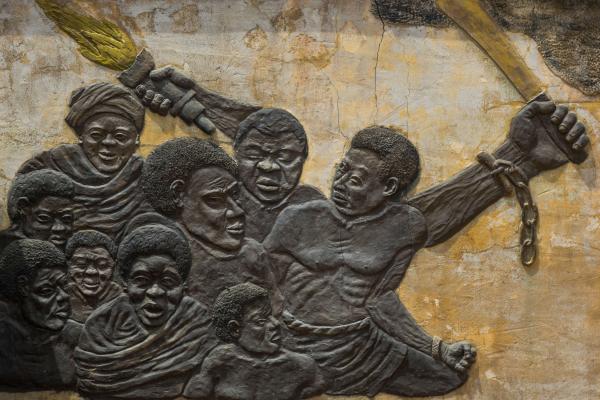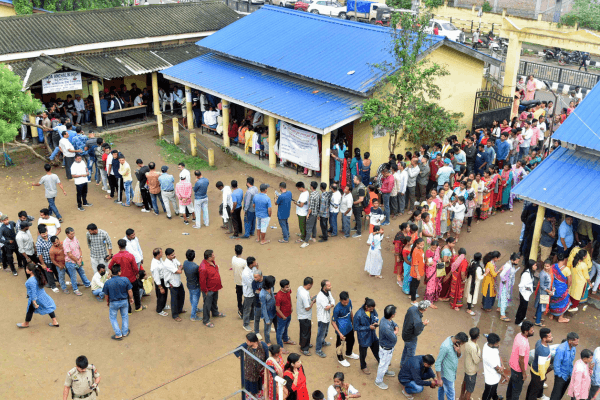As the sun sets on each Election Day, people turn to exit polls to understand what happened and why. After the 2020 presidential election, exit polls suggested that outgoing President Donald Trump performed better among Hispanic/Latinx voters, earning reactions from pundits and former presidents alike. Some have suggested this is due to splits among Hispanic Catholics and Hispanic Protestants, but polls alone may not tell the full story.
“People were surprised about a lot of Hispanic folks who voted for Trump,” former President Barack Obama said on the Breakfast Club podcast on Nov. 25. “But there are a lot of evangelical Hispanics who, you know, the fact that Trump says racist things about Mexicans, or puts detainees, undocumented workers in cages, they think that's less important than the fact that he supports their views on gay marriage or abortion."
Jorge Juan Rodríguez V, a historian and doctoral candidate at Union Theological Seminary, agreed that Hispanic Protestants may have separate concerns than their Catholic counterparts. But he challenged the notion that the voting bloc be thought of as monolithic.
“There are definitely reasons we could attend to as to why the numbers skew the way they do with Latinx Protestants tending to move a little more conservative than Catholic Latinos,” Rodríguez said. “In many respects the trends among Latinx voters followed the same trends among white voters. The question that arises for me is whether or not we also see Latinx as a diverse and heterogeneous voting bloc that has complexity and diversity within it.”
He said that organizers working in different Hispanic sub-groups mobilized turnout among respective groups. For example, he cited the National Hispanic Christian Leadership Conference as a group that has joined nonpartisan voter registration initiatives among more evangelical and religiously conservative Hispanics, whereas grassroots organizers in Arizona and Nevada focused on improving local Hispanic/Latinx turnout and registration.
“A lot of the complexity in the community is often flattened, because if it was made politically complex, how then would you market to a working class Black Dominican in Harlem, and a brown Chicano in L.A., and a white Cuban in Miami?” Rodríguez said. “Latinx voters are a diverse constituency and from the religion perspective, the reality is that religion never occurs outside of our social context, our economic realities, or our familial realities.”
Exit polls aren't great
The flattening Rodríguez describes can be attributed in part to exit polls, which are conducted by pulling aside voters who are leaving a voting station and asking them a series of questions — often with only a checkbox to record participants’ ethnicity. Ryan Burge, assistant professor of political science at Eastern Illinois University, said that data from exit polls should always come with caveats — especially in 2020.
“[Exit polling] is not great and it’s never been that great because even in a normal year you’re not getting a random sample because the people who agree to do the exit poll are not a good representation of the people who voted that day,” Burge said. “And they’re even worse this year because half the people that voted this year ... never exited a poll.”
Burge said politicos and media institutions tend to rely on exit polls because exit polls offer fast data for pundits to discuss immediately after the election.
The more accurate and specific data about Hispanic voting subgroups (Catholics, evangelicals, etc.) won't be available until May or June, Burge said.
Rodríguez wondered why Hispanic voters often come under a microscope that few other racialized groups do.
“That Latinx Christians, whether Catholic or evangelical Protestant, are going to engage their faith differently than white folk? Sure, that’s definitely a thing,” Rodríguez said. “Whether or not that distinction within the group is substantially distinct enough to note a distinction between white Catholics and white Protestants? I’m not sure.”
The difference between Catholics of different ethnicities or races isn’t the only thing coming under scrutiny from experts like Rodríguez. Pundits also expressed surprise about the Hispanic and Latinx faith voters who cast ballots for Trump. While specific counties might be worth studying for the changes seen from 2016 to 2020, the overall trend of Republican Hispanic Catholics is fairly consistent. Bush won 33 percent in both elections, John McCain and Trump won 26 percent, and Romney won 21 percent.
Rodríguez questions why the media emphasizes this data every four years. “Latinos have huge voter turnout, they don’t vote necessarily whatever the imaginary is that they should vote, and then [pundits wonder why],” he said.
Some have also suggested that this split among Hispanic faith voters ought not be surprising, considering the data we had before the election. For example, the Public Religion Research Institute recapped how their polling suggested a split earlier in 2020.
“A majority of Hispanic Protestants approve of Trump’s job in office (57%) and his performance with the economy (58%). Hispanic Catholics and those who are religiously unaffiliated are considerably less likely to approve of the president’s job in office (27% and 16%, respectively) or his performance with the economy (42% and 28%, respectively),” Natalie Jackson wrote for the institute.“Hispanic Protestants are also more likely to approve of how Trump has dealt with racial justice protests than Hispanic Catholics or those who are religiously unaffiliated (45% vs. 30% and 11%, respectively).”
Better data
It’s also possible that the different outcomes in states like Nevada, Arizona, Florida, or Texas should be attributed to the efforts from the campaigns and grassroots organizers.
The most reliable data for analyzing election results comes from databases known as “voter files.” Public information on who is registered to vote and whether they voted, which comes from secretaries of state or county recorders, is combined with data from political organizations or other data vendors to create a “voter file.” Of course, how an individual voted is private, but that they voted or how they register is public information. This in-depth data isn’t usually available until March or April, as public officials release information in January or February and voter file databases are created after that.
In place of unreliable exit polls, analysts are using precinct-level data in the weeks after an election. Chris Brill, who performs data analysis for Mi AZ, a coalition of six organizing groups in Arizona (Living United for Change in Arizona (LUCHA); Chispa Arizona; Mi Familia Vota; CASE Action/ UNITE HERE Local 11; Our Voice, Our Vote; and Progress Arizona), said precinct data is the “smallest geographic unit of analysis we’re able to look at when it comes to election results.”
A precinct can be anywhere from several hundred voters to several thousand, and knowing the makeup of a precinct can help track voter performance. Comparing Latino-majority precincts can help explain differences among voters.
“[W]e look at the top hundred or 150 precincts that have the highest percentages of Latinos and we looked straight at turnout and partisan performance,” Brill said. “Turnout was really high ... in terms of performance we’re still trying to tease that out a little bit.”
In Arizona, Latino majority precincts in suburbs near Phoenix voted for Democrats at higher margins than Latino majority precincts in rural parts of southern Arizona. While it isn’t as surefire as voter files, it gives an indication that rural Latinos were more likely to vote for Republicans in the last election.
On Nov. 11, Mi AZ predicted a total of 3,425,000 votes would be tallied in Arizona; the final number was 3,420,000. Their projections for turnout suggest Latino voters increased turnout by 16 percent, 6 percentage points higher than the total increase in the state.
Regardless of what happens now or when the full voter files come out, Brill said that they will not be able to give great indication as to splits among faith voters.
“[Religion is] very tough for us to analyze; we don’t have voter file data on that. We do some polling on that, but it's very hard to tease out when we’re doing individual level targeting,” Brill said. “I don’t know the answer to [finding data on religious voters] … we don’t have great resources to drill down on that at a community level.”
Got something to say about what you're reading? We value your feedback!







